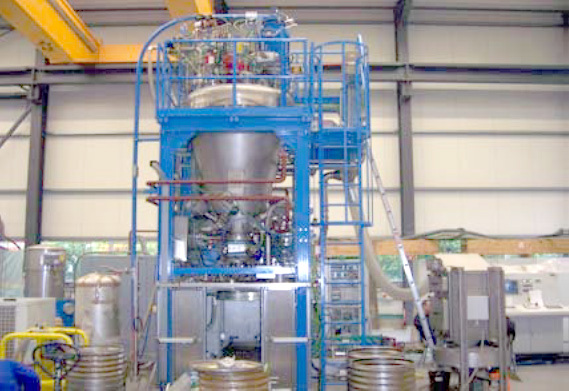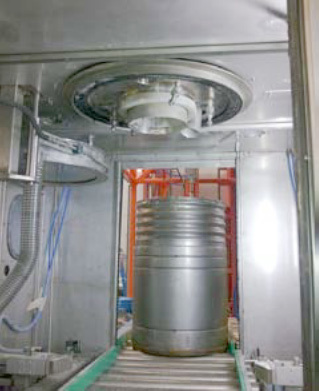
Full view of conical dryer
Background
The Westinghouse Hot Resin Supercompaction (HRSC) process is applied for volume reduction of organic bead and/or powder resin. It was developed more than 20 years ago to address the specific waste characteristics of one nuclear power plant. The presence of both powder and bead resins was considered in developing the process to address the needs of both pressurized and boiling water reactors. The most critical issue for a successful process configuration is the duroplastic behavior of resins, in particular of the bead resins. This behavior prevents the resins from building a homogenous, solid block and, in the worst case, bursting the metal surface of the pellet, known as the spring-back effect. Various laboratory and full-scale trials had to be performed to adjust the process parameters to address this issue.
Description
Drying in a conical dryer is the key component of the Westinghouse HRSC process. This is a thermal process whereby water is evaporated from the ion exchange resins until 4 weight percent humidity is reached. As an improvement option, the Westinghouse HRSC NextGen grinds the resins before drying to reduce the drying time and to improve their compactability. Grinding of bead resin results in a better volume reduction factor than pure bead resin processing. The HRSC condensate system enables the filtering and the condensation of the steam from the conical dryer. The conical dryer is cleaned automatically.

View under the conical dryer
Benefits
The benefits of the Westinghouse HRSC process include the following:
- Drying is a proven process used throughout the nuclear industry.
- Drying is relatively inexpensive and is comparable to incineration or cementation.
- Conical dryers are simple, reliable and easy to operate.
- No secondary waste is being generated.
- It reduces spring-back effects.
- It results in a high-volume reduction of approximately 1.8 to 4 (depending on the resin).
- It produces a stable mono-block matrix of compacted resin.
- Both bead and powdered resins can be processed.
- It offers good volume reduction without creating gaseous effluents.
- The process does not increase the specific activity (Bq/kg) of the waste.
Experience
Westinghouse has successfully implemented the HRSC process in Germany and Belgium. Another facility is under construction in China as part of a larger radwaste treatment facility.



